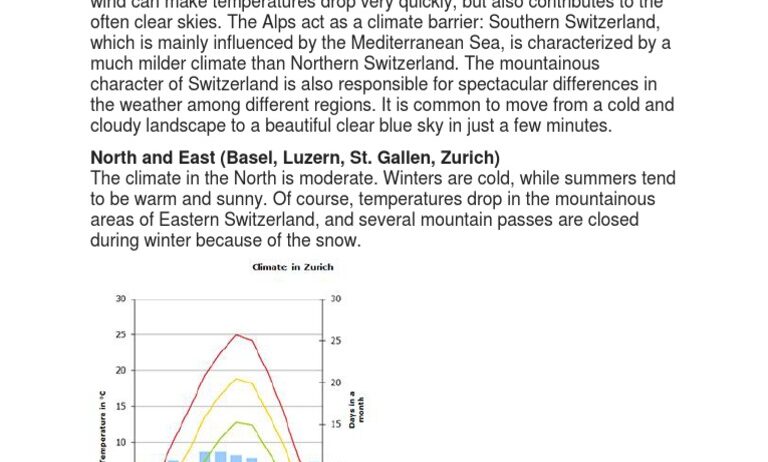Switzerland, a landlocked country nestled in the heart of Europe, is renowned not only for its breathtaking scenery but also for its distinctive climate that harmonizes with the dramatic Alpine landscapes. With mountain ranges that stretch majestically across the nation, including the iconic Swiss Alps, the climate of Switzerland presents a fascinating interplay of meteorological phenomena that reflects both regional variations and seasonal transformations.
The climatic condition in Switzerland is predominantly classified as temperate, characterized by four distinct seasons: spring, summer, autumn, and winter. Each season brings unique charms and challenges to the various regions of this picturesque nation, from the dazzling snow-capped peaks to the verdant valleys and pristine lakes.
As one navigates through the Swiss territory, it becomes evident that altitude plays a critical role in shaping local weather patterns. The topography reveals a complex tapestry of microclimates, with lower-lying areas enjoying milder conditions, while alpine regions endure harsher climates. For instance, cities like Zurich and Geneva, located at a relatively lower elevation, experience a temperate climate with moderate precipitation and warm summers, where average temperatures can climb to around 25°C (77°F).
Conversely, as one ascends to the higher altitudes found in the Alps, the climate shifts dramatically. The weather becomes cooler, with summer temperatures often scaling down into the low teens and harsh wintry conditions setting in during the colder months. The snow line, an important reference point, can vary significantly; generally, it hovers around 2,500 meters (8,200 feet) in the Alps during the summer months while descending further in winter. This phenomenon not only captivates outdoor enthusiasts but also affects the biodiversity that flourishes in these varied environments.
Transitioning from the balmy summer days, autumn in Switzerland unveils a canvas of gold, red, and amber hues. The crisp air, scented with fallen leaves, invites introspection. This season serves as a poignant reminder of the inevitability of change. September can still be relatively warm, but as October progresses, a noticeable chill begins to seep into the atmosphere. Rainfall increases, but the fog rolling in from the valleys has a gently haunting aura, creating an ethereal landscape that captivates both local and visiting observers.
Winter in Switzerland transforms the country into a snowy wonderland, attracting tourists and locals alike who revel in outdoor sports such as skiing and snowshoeing. The Alps become a hive of activity, drawing crowds to engage in winter festivities. However, these snowy seasons bring about environmental changes that deserve contemplation. Rising temperatures globally have begun to impact snowfall patterns, presenting challenges to ecosystems traditionally reliant on snow cover.
The profound effects of climate change are palpable in the Swiss landscape. Glaciers, once massive entities shaping the Alpine contours, are now retreating at alarming rates. The Aletsch Glacier, the largest in the Alps, has shrunk significantly since the late 19th century, illustrating a stark and urgent narrative about the fate of these icy behemoths. Such changes forecast rising sea levels and altered river systems, echoing across borders, impacting not just the Swiss environment but reaching far beyond national confines.
Amid these climatic shifts, the Swiss are undertaking efforts to harmonize human activities with nature through sustainable practices and policies. Renewable energy sources, such as hydroelectric power, are abundant in this mountainous terrain, accounting for approximately 56% of Switzerland’s electricity production. This commitment to clean energy, coupled with innovative sustainability initiatives, showcases an admirable effort to mitigate carbon emissions.
Spring emerges like a gentle rebirth, with nature reawakening from the slumber of winter. The snowmelt replenishes rivers and lakes, and wildflowers begin to dot the meadows. This season not only brings a revival of flora but also serves as a critical period for agriculture; farmers prepare for planting crops that thrive in the mild temperatures. The balance maintained during this season, when combined with conscientious farming methods, demonstrates a resilient and adaptive approach to climate variability.
Switzerland’s exquisite climate fosters not only environmental conditions but also cultural practices rooted in an appreciation for nature’s majesty. Swiss traditions often reflect the rhythm of the changing seasons, whether it’s the celebration of local harvests or the preservation of old rites linked to winter and spring. This cultural synergy between people and their environment is an indelible thread woven throughout Swiss life, enhancing the value placed on ecological conservation.
In summation, the climate of Switzerland is characterized by its remarkable contrasts, shaped by altitude and seasonal variability. From the vibrant summers to the serene, snow-laden winters, each season offers a fresh canvas that invites reflection on nature’s magnificence and fragility. However, as the nation grapples with the implications of climate change, it stands at a crossroads, armed with opportunities to lead through sustainable practices. The calls for collective action ring loudly—not just for the preservation of the Swiss Alps but for the planet itself, urging an awakening in hearts and minds to champion the cause of environmental stewardship.
The diversity of Switzerland’s climate serves as both an inspiration and a reminder of the pressing need to adapt to and mitigate the challenges posed by climate change. Through informed dialogue and concerted efforts, a collective shift in perspective can emerge, igniting curiosity and motivating actions that safeguard not only the enchanting landscapes of Switzerland but the global environment as a whole.






